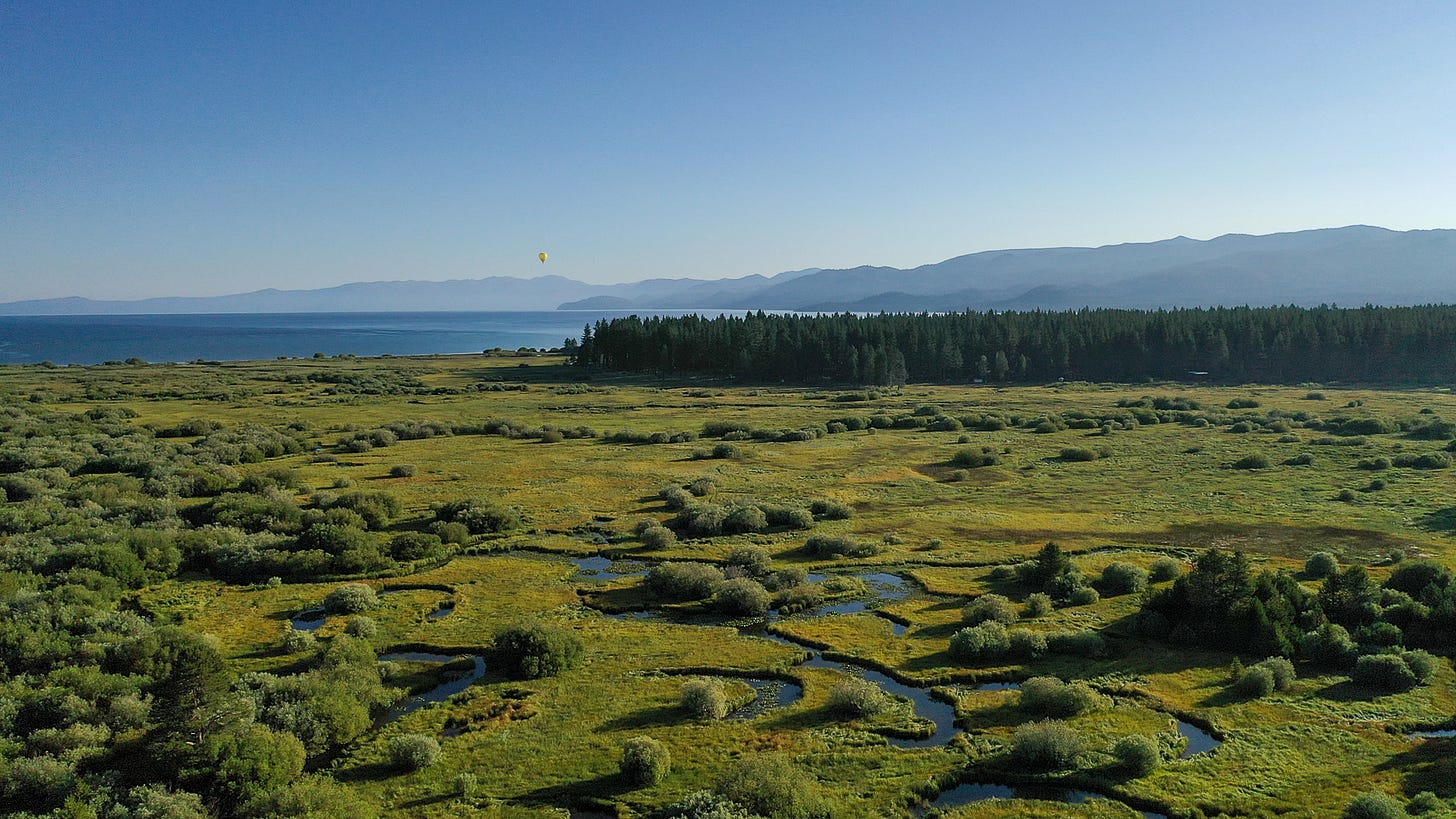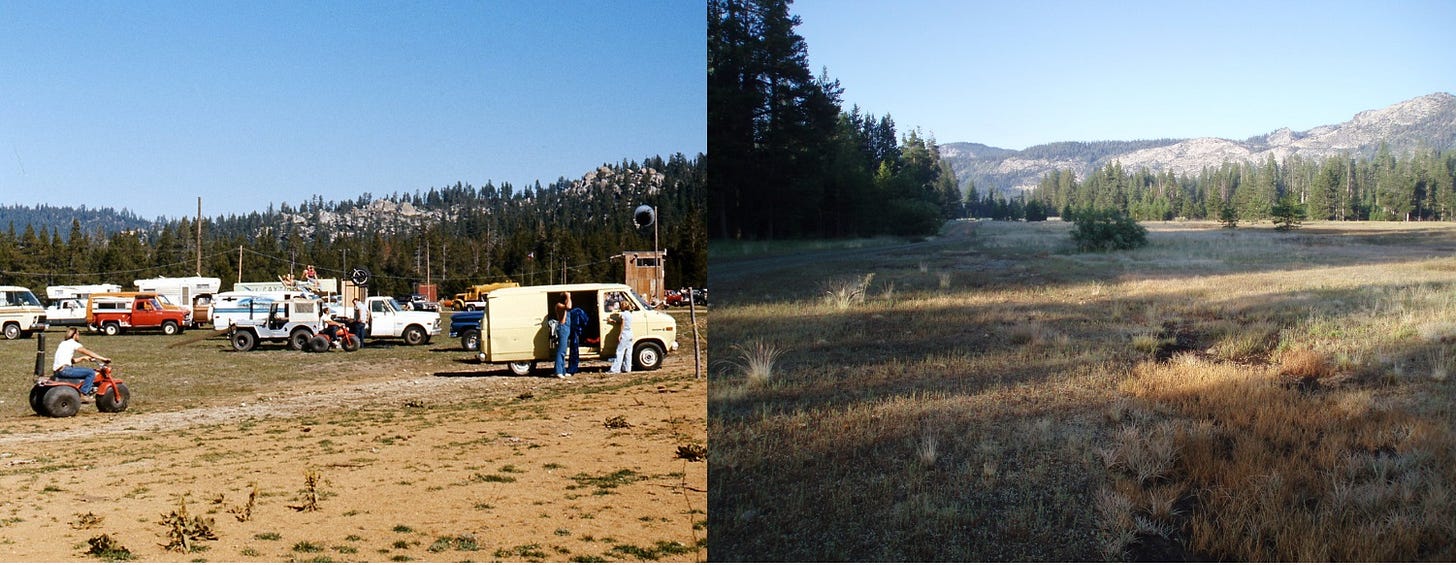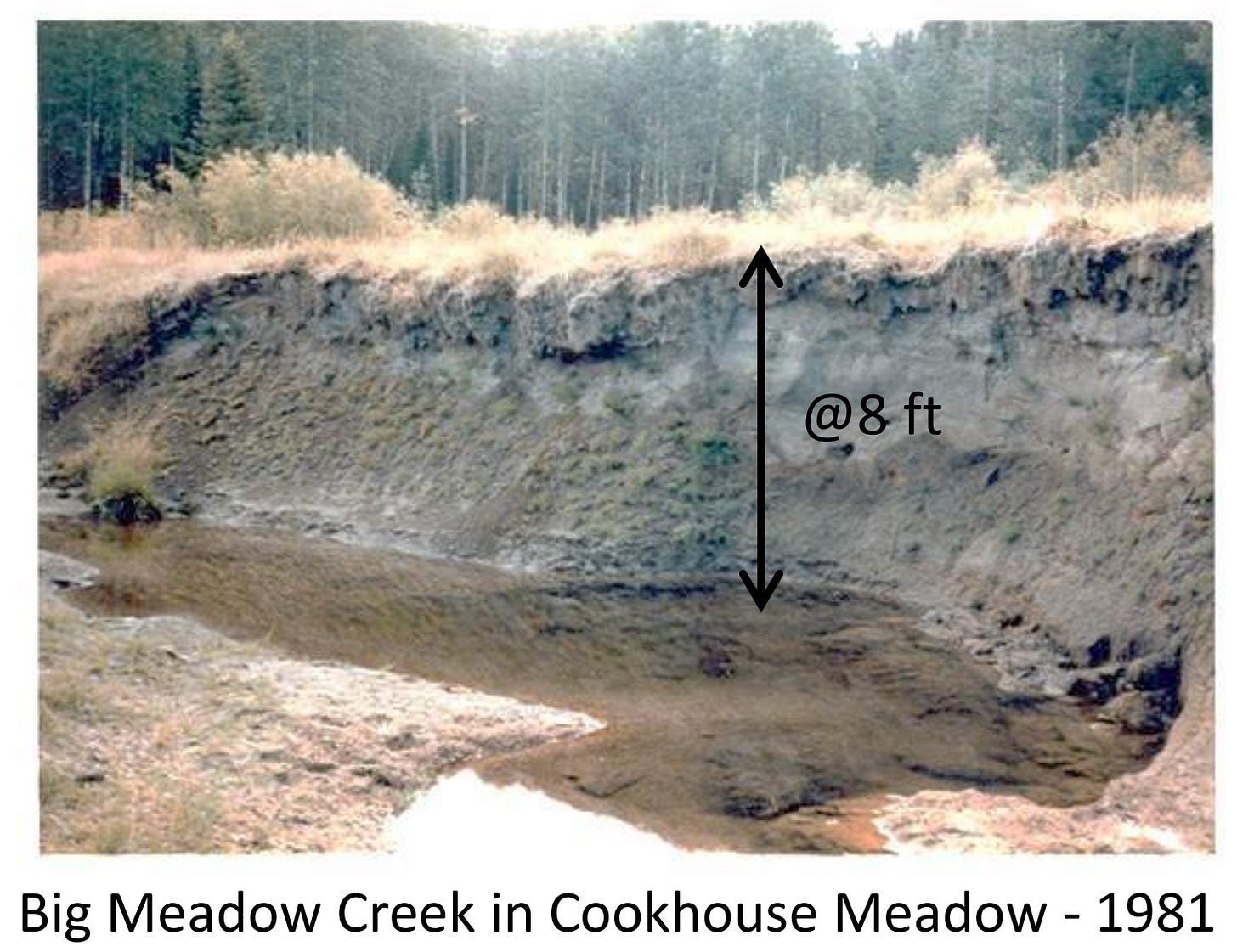Tahoe's sandhill cranes show wetland restoration is working
Connecting the dots on why a threatened, marsh-loving bird might choose a region that has spent $3 billion in four decades on its environment
Sandhill cranes have discovered Lake Tahoe’s restored meadows, with four pairs breeding at South Shore in 2024, including a marsh that was rehabilitated as recently as last year. This follows four decades1 of immense effort to stop development and grazing, rebuild roads to prevent erosion, and actively revive all remaining wetland in the Tahoe Basin.2
Since 2000, the American people have spent nearly $3 billion restoring Lake Tahoe’s environment after it was logged, grazed, dredged, paved and developed to near death. Much of this restoration has been designed to encourage Tahoe’s meadows to get wet, stay wet, and act as the super filtration sponges and ecosystem boosters nature intended them to be.

Now, it appears those efforts are bearing fruit with the arrival of an absolutely stunning bird, one listed as threatened in the State of California. While sandhill cranes are abundant in the Midwest, fewer than 500 pairs call California home.
Will Richardson with the Tahoe Institute for Natural Science worked hard to raise awareness of the cranes’ nests this spring, but elsewhere, the reaction from Tahoe’s environmental camp has been … crickets. More on this later.
Birders say cranes are multiplying in Tahoe because they’re “not hunted anymore” and “it was a wet winter.” These explanations are certainly valid, but they don’t capture the whole story. Hunting sandhill cranes has been illegal in California since 1918 and Tahoe has seen many wet winters since then.
Consider this: Commencing as early as the 1850s, nearly every inch of Tahoe’s meadows has been heavily grazed by cattle, sheep and horses. Beavers, our beloved wetland engineers, were already hunted to extinction3 in the region even before silver or gold miners arrived. Then, in the 1950s and ’60s, developers dredged, paved and infilled a majority of Tahoe’s wetlands.
This left meadows straining for life, streams suffocated or cut down by eight feet or more, and vegetation drying out. Rivers straightened into ditches that funneled mud directly into the lake. Even in “wet years,” meadows would not flood. With no grass, willows and wildflowers, all the bugs, birds, amphibians and small burrowing animals lacked vital habitat. So, of course, no big fauna like cranes would stick around to chase this nonexistent food.
Honey, that looks like a nice meadow down there
Tahoe began to turn the ship after 1980. The lake was losing the famed clarity John Muir and Mark Twain noted 100 years prior. Environmental groups, communities and land managers began a concerted effort to revive Tahoe’s ailing wetlands. Today, $3 billion and a few debates4 later, Tahoe boasts huge wetlands that sandhill cranes are finding very alluring.
We know that healthy meadows bloom with wildflowers that feed a multitude of insects, birds and small mammals. High-functioning meadows are sponges that are wet enough year-round for willows to thrive, creating great protective habitat for large birds. With plentiful willows to eat, beavers move in and help engineer more wetlands. Delicious crane food like frogs, voles and moles multiply, not to mention the fish nurseries that flooded meadows host with their small, braiding rivulets of sheltered, shallow channels.

Though they just made news this spring, cranes have been staging a quiet comeback for almost ten years, with a birder telling Tahoe In-Depth they’ve seen one in South Shore each year since 2015. This year, eight huge, 12-pound birds chose to raise chicks in four wetlands, a clear indication Tahoe is once again home to healthy, functioning and thriving ecosystems.
Which version of this meadow would you prefer?
Cookhouse Meadow is a 25-acre wetland just downstream of Grass Lake, where one of the pairs of cranes nested. It’s a perfect example of how meadows were degraded by grazing and poor road design and then later restored.5 Tahoe’s land agencies have conducted similar projects on over 1,100 acres of wetlands in the last 30 years.
A look at restoration work in or near the nesting sites
Two of the sandhill cranes’ 2024 nesting sites received significant restoration in the last 20 years, resulting in a transformation from dry to wet habitat:
Upper Truckee Marsh
Adjacent to the Tahoe Keys, the 560-acre Upper Truckee Marsh was dredged, dried and sacrificed to cattle until 2001. Since then, the California Tahoe Conservancy has placed enormous effort into resuscitating it, since this is the exit point for all sediment carried by the lake’s main tributary. When restoration began 20 years ago, it took 8,000 dump truck trips to remove the dirt the Tahoe Keys developers left behind in the ’60s. In 2023, the Conservancy completed an $11 million project to ensure the meadow floods and slows the flow of sediment into the lake, the largest restoration of this type in Tahoe’s history. It’s no coincidence cranes decided to nest here.
Sadly, this nest appears to be the one that wasn’t successful in 2024, with birders blaming kayakers, though there are a host of other threats, including osprey, eagles, coyotes, bobcats, pets and bears, not to mention aircraft and motorboat noise.
Washoe Meadows State Park
This 861-acre park was purchased by the State of California in the 1980s after a new regional plan halted a huge planned subdivision. The park contains a fen, a unique type of peat-forming wetland that takes thousands of years to form. Washoe Meadows received many upgrades in the 2000s that helped it transform from a dried out field to a lush meadow, including an updated sewer line, restoration of Angora Creek from straight to meandering, and a bridge through a flooded area so that pedestrians and bikes wouldn’t trample vegetation. More restoration is in store for this park, since Lake Tahoe’s largest tributary, the Upper Truckee River, passes through it.

The next two sites are usually quite wet and flood well during heavy snowmelt. Though altered by highways and pavement, they have not required as much restoration.
Pope Marsh
Pope Marsh (150 acres) sits on the other side of the Keys from the Upper Truckee Marsh and is surrounded by pavement on four sides, except one small length of lakefront sandbar. This includes a parking lot that provides beach access to some of Tahoe’s 15 million strong throngs of yearly tourists. Since it’s so close to the lake, the marsh’s water level tracks pretty closely with lake level, which reached its maximum height again this year.6 The area is benefiting from $23 million in stormwater drain improvements along Highway 89 that encourage water to seep slowly into the ground, recharging wetlands instead of running along the road and causing erosion. Gardner Mountain Meadow, which would be contiguous with Pope Marsh if it weren’t for the highway running through it, received restoration work on 10 acres in 2014.Grass Lake
At 2,400 acres near the Lake Tahoe Basin’s southernmost tip, Grass Lake is the Sierra Nevada’s largest floating or “quaking” bog, making it the most unique of the cranes’ nesting sights. Except in winter, when it’s a cross-country ski destination, this giant floating matt of grass is difficult for people or predators to traverse, which could be why there’s little sign of historic cattle grazing. If I were a crane, I’d feel somewhat safer from the coyotes, bears and human pets here.The bog runs adjacent to Highway 89 for several miles, which in 2010 received new stormwater drains for $26 million between Meyers and Hope Valley. The drains prevent a gully of mud from running downhill alongside the highway. These road improvements ideally allow more snowmelt to seep into the bog, especially from the north, where previously the highway would have blocked and diverted some flow. Sandhill cranes were first spotted nesting at Grass Lake in 2018.7 8
Nowadays, what the cranes see when they fly above South Shore is not one nice marsh, but several, spanning thousands of acres, creating an interconnected hunting ground and a vast buffet by which to feed their chicks.

How do we measure success?
Tahoe’s media and environmental community9 maintain a nearly singular focus on one quality measurement: the annual clarity reading released by UC Davis researchers. In a nutshell, it’s an average of how far down you can see a white plate (Secchi disk) when it’s lowered into the lake.
When the Secchi disk speaks, it rarely says anything sexy. Scientists have been measuring the lake’s clarity this way consistently for decades, so there’s a lot of solid data. Ideally, we do all this environmental restoration, the wetlands filter out all the sediment before it clouds Lake Tahoe, and the Secchi disk tells us clarity is improving. Instead, it says, “maybe” and “not so fast” and “climate change.”
How else could we possibly gauge progress?10
Well, some flamboyant, red-capped, lovers-for-life sandhill cranes have shown up, flapping their dinosaur-sized wings and tossing grass into the air; dancing their courtship jig and squawking their bugling love calls; and proving all this restoration work created real, functioning wetlands out of dried up pastureland.
That’s a sign of some good work. I’m placing bets that many more cranes are on their way.
If they take hold in Tahoe, cranes would be the region’s largest charismatic megafauna next to bears. Mountain lions are rare. Deer are scarce. A few bald eagles and osprey call Tahoe home. But, at four feet tall and with an almost seven-foot wingspan, sandhill cranes outstretch anyone else.
Fear sells, but hope works, too
Back to the “crickets” comment. Each marsh and meadow is managed by a different agency funded by another department somewhere far away. Tahoe’s overlapping federal, bi-state, state and local jurisdictions are dizzying at best, and there’s no one grand pooh-bah to declare “success.” Anyone involved in environment work is also subject to abuse by a variety of critics, including cranky locals, developers, politicians and even opposing environmentalists, and risks getting chewed up and spit out any time they publicly say a word about anything.
So, it appears everyone’s happy the cranes came but nobody’s willing to say, “We did it.”
Maybe it would be too off-message to admit success. Much public and private funding for environmental causes is driven by fear-based, threat-based messaging. It’s difficult— and perhaps risky — to switch to a more optimistic, “We’re succeeding; let’s build on this.” Ingrained habits urge us to keep the masses worried that they’ll lose something precious if they don’t “act now.”
I hope this isn’t the reason for the stone-cold silence on cranes in Tahoe. It might instead be a shy reticence to conceive the wetlands are actually thriving, a fear that the cranes might not return when drought hits again, true pessimism about the future, or a hesitance to jump to conclusions. A reluctance to embrace hope.
Maybe they’re just too busy to connect the dots. Saving Tahoe gets that way.
These iconic cranes are an irrefutable indicator we are saving Lake Tahoe. We can do the same with rivers, lakes and wetlands around the world.
There’s much more work to do. But this is a true success story. Tahoe should be proud.
“As it lay there with the shadows of the mountains brilliantly photographed upon its still surface, I thought it must surely be the fairest picture the whole earth affords.”
— Mark Twain on Lake Tahoe
“Tahoe is surely not one but many. As I curve around its heads and bays and look far out on its level sky fairly tinted and fading in pensive air, I am reminded of all the mountain lakes I ever knew, as if this were a kind of water heaven to which they all had come.”
— John Muir
Recent headlines from Earth Hope:
How paying farmers saved the tricolored blackbird
Claim your square of this planet
Photo essay: Solar farms doubling as prairie regenerators in the Midwest
Illinois tells HOAs to stop banning native plants in yards
Land managers reconsider their anti-beaver stances
About Earth Hope:
Earth Hope highlights environmental success stories from around the globe, because hope is the foundation of progress. We’re not interested in “neat” or unproven ideas, but in solutions that are working right now on the ground in communities across the world. Fear-based headlines and conflict-based journalism leave us feeling paralyzed. While we must know and understand the bad news, we should also remind ourselves frequently that progress happens every day. Therefore, in some ways, this is not just a journalism project, but a mental health project. Thanks for reading.
About me:
I’m Amanda Royal, a former newspaper reporter who covered wildfires, invasive species, water quality, wildlife and other environmental topics in California and Nevada (while writing under my maiden name and byline Amanda Fehd). The pseudonym “Earth” was a bit accidental. It grew on me quickly, so I thought I’d keep it for a while.
Too many Substack emails?
Download the app, where you’ll have the option under “settings” to “prefer push notifications” without unsubscribing to all your favorite writers.
A brief timeline:
1987: Tahoe Regional Plan prohibits development in any wetland within the Tahoe Basin.
1997: Tahoe Environmental Improvement Program (EIP) launches to secure public funding to improve stream restoration and stormwater runoff infrastructure, among other goals.
1999: Forest Service bans cattle grazing in Big Meadow Creek and Upper Truckee River watershed due to bacterial contamination and pressure from Lahontan Region Water Quality Control Board.
2000: Original Lake Tahoe Restoration Act passes Congress, provides money for wetland restoration.
2002: Forest Service bans cattle grazing in 12,000-acre Meiss Meadows, the southernmost reach of the Tahoe Basin watershed.
2012: Tahoe’s current regional plan encourages removing development from meadows. Developers can buy and restore parcels in meadows in exchange for development rights elsewhere.
2024: Nearly 1,100 acres of meadow and stream habitat have been restored as part of the EIP.
2024: We’re not done! California Tahoe Conservancy buys 31-acre site that includes Motel 6, which was built on a meadow with eight feet of infill. The purchase allows the Conservancy to remove the motel and connect the the Upper Truckee Marsh (crane nesting site number one above) with another several hundred acres of floodplain south of the highway. I’m hoping the future for Highway 50 here is a raised bypass similar to what Maui installed to traverse its Keālia Pond National Wildlife Refuge.
The “Lake Tahoe Basin” is a watershed as well as a jurisdiction. It covers the 500 square miles of tributaries draining into Lake Tahoe. In addition, a unique bi-state regulatory system, the Tahoe Regional Planning Compact, was created by California and Nevada and ratified by Congress in 1969 and again in 1980 to oversee the watershed, regulate development and restore the lake. The Tahoe Basin stretches across two states, five counties and one incorporated city.
“Eager: The Surprising, Secret Life of Beavers and Why They Matter,” by Ben Goldfarb.
An understatement
“Cookhouse Meadow gets a face lift,” by Amanda Fehd (yes, that’s me😊)
The top six feet of Lake Tahoe is a reservoir, with a small dam in Tahoe City run by the Bureau of Reclamation. The lake’s maximum elevation is 6,229 feet. During drought years, the lake can fall below the level of the dam.
Notably, 2018 was an average winter, but it followed the heavy winter of 2017. Likewise, 2024 was a slightly above-average winter, but followed the off-the-charts winter of 2023, when Tahoe received four feet of snow ten weeks in a row.
“Tahoe’s evolving fauna,” by Will Richardson, Summer 2019 issue of Tahoe Quarterly
I’m a recovering member of both. I don’t have any current affiliations with any Tahoe groups.
The 1987 Regional Plan established standards called “environmental thresholds,” including a wildlife threshold, but only policy wonks pay attention to these.






This is amazing! I visited Lake Tahoe in the 1970s on a family holiday and it's wonderful to see all this positive work being done to restore the ecology. Sandhill Cranes!
I'm in Australia and this success story made my heart sing.
Thank you.